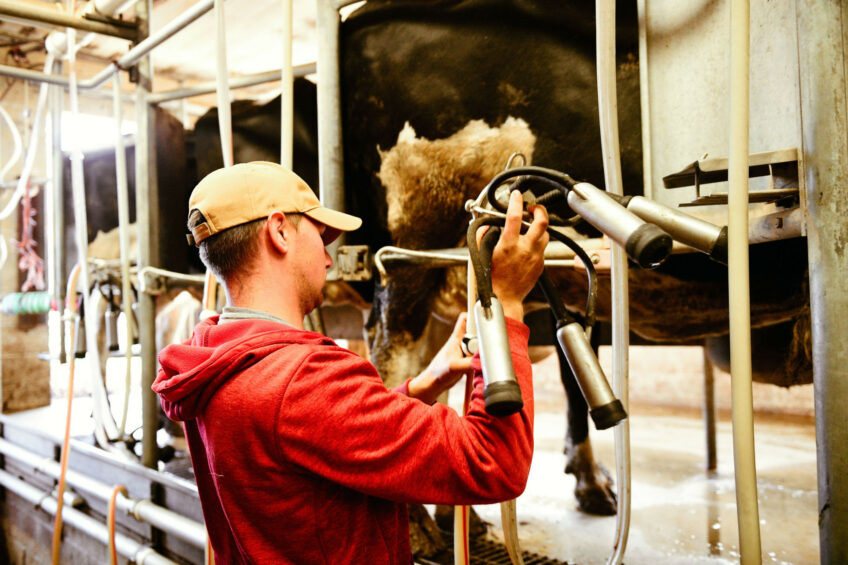Farm report: Michigan, US: What it’s like to have bird flu in the dairy herd

A farm in Michigan in the US takes us through its journey of how the herd has been affected by avian influenza, and offers insights into how it experienced dealing with the virus on-farm. Michigan’s state currently has 19 farm cases of highly pathogenic avian influenza.
The herd at the dairy farm in Michigan has approximately 500 lactating cows. Prior to infection, the average cow production on this farm ranged from 95-100 lbs (42-45 litres) per day.
Avian influenza detection
1 May marked day one of the onset of an outbreak of Highly Pathogenic Avian Influenza (HPAI) on a dairy farm in Michigan. Initial symptoms were detected with the SmaXtec monitoring boluses that they currently have in about 90% of lactating cows. The onset was manifested by a spike in body temperature of 4-5°C above normal, followed by a decrease in rumination 6 hours later. The decrease of rumination in infected cows was severe with almost no activity occurring.
The temperature elevation lasted about 2 days and there was a sharp drop in water intake by infected cows from 40-50 gallons (151-189 litres) to 5-10 gallons (19-38 litres) per day. These conditions resulted in severe dehydration in the cows. The farm took an aggressive approach to supportive therapy, administering aspirin boluses twice a day to reduce temperature and inflammation. They also provided vitamin B and a rumen yeast capsule for a minimum of 3 days. For cows that refused to drink, they administered hypertonic saline IV. They tried IV Banamine on a limited number of cows but did not see any positive impact. Their goal was to make the cows as comfortable as possible.
HPAI spread to lactating cows
It began in a barn with 2 pens of cattle that had 3 water fountains, the centre one being shared. They wanted to try to confine the disease to a single group or at least a single barn. They changed their wash cycle in milking so that it washed after this group of cows. Regardless of their efforts, HPAI spread to all groups of lactating cattle on the farm.
For the first 9 days, milk production per cow only decreased by about 5 lbs (2.2 litres) and the farm was optimistic they had beaten back the disease. However, by day 12, each cow was producing 21 lbs (9.5 litres) less than average, accompanied by a doubling of somatic cell count to 180,000 c/ml. Cows were dehydrated with sunken eyes. Day 15 was the first day that the monitoring report showed fewer cows affected than the day before. Based on the number of cows with elevated temperatures and subtracting out the normal rate, they believe 40% of the lactating herd was infected.
The number of cows the farm employees needed to handle in some way had increased sixfold, making the work very labour intensive. Breeding stopped during this time because of the demands of just working with sick cattle.
While pregnancy checks had not at this point shown a reduction in conception, multiple late-lactation (150-220-day) cows had aborted their calves, and the farm believes this is due to high body temperatures. The disease primarily affected high-producing, multi-lactation cows and the low group. Transition cows seem to be performing normally at this point. Waste milk was pasteurised before feeding it to calves, and to date, the calves seem to be doing fine.
Employees have stayed healthy to date. The farmer encouraged them to wash their hands frequently and avoid touching their face and eyes. All employees were offered safety eyewear or face shields.
Herd costs and recovery
The farmer did some cost estimations – he spent US$5,000-$7,500 in extra medical supplies. Even though the costs of these common medications are low, the volume needed has been quite high. There was a loss of milk, loss of quality premium, increased labour, and loss of a few pregnancies resulting in culling animals. He estimated the cost for this herd of approximately 500 cows at US$30,000-$40,000.
By day 24, the farmer said that some cows — approximately 10% that were infected — have not recovered rumen activity. It is likely that these cows will be culled because they are not regaining weight and health. It appears that there are some individual cows that have a “long” form of the disease.
The owner of the farm in this report understands that this does not include the potential longer-term costs. Another farmer said that some herds are seeing symptoms for 4-6 weeks. Additional negative impacts include increased culls of animals that do not recover significantly and increased weight gain of late lactation cows that recover feed intake but not milk output.
“It has been a lot of work, stressful on the cows and frankly overwhelming,” the farmer said.
Join 13,000+ subscribers
Subscribe to our newsletter to stay updated about all the need-to-know content in the dairy sector, two times a week.










